ASUS N10JC: the Netbook Goes Corporate
by Jarred Walton on December 24, 2008 4:00 AM EST- Posted in
- Laptops
Battery Life and Power
We will start with measurements of power use with the laptop plugged into the wall. Keep in mind that some power saving features are not fully functional unless you are running on battery power, but it's still interesting to compare power requirements with other laptops under similar conditions.
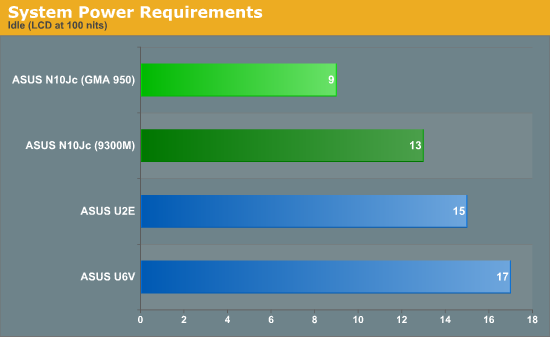
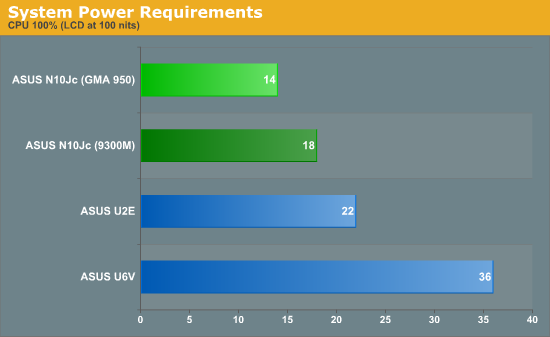
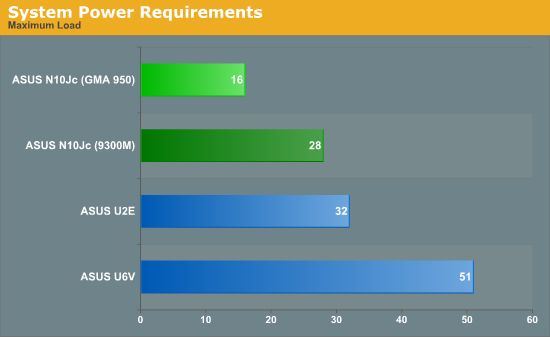
We see a significant drop in power requirements relative to the ultra low voltage Core 2 Duo U9500, especially when we disabled the 9300M. In best case scenarios, we should see almost twice the battery life for the same size battery capacity, and at worst battery life using the GMA 950 should still be 50% better. Even with the discrete graphics enabled, battery life should still be better than the U2E by a decent amount.
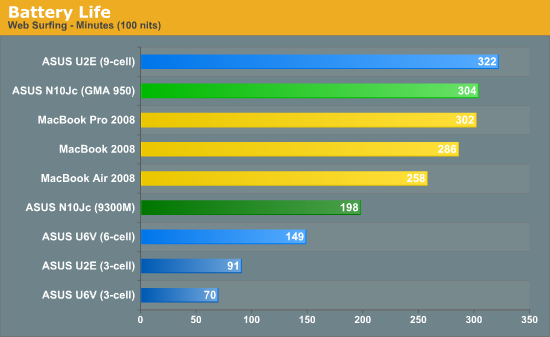
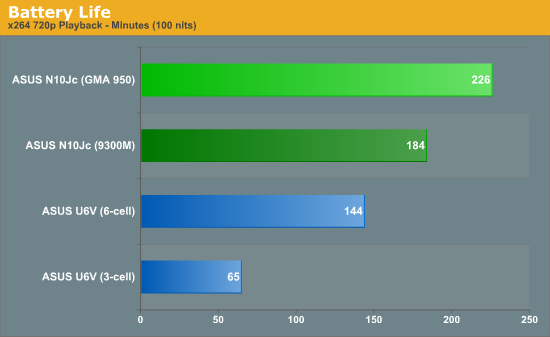
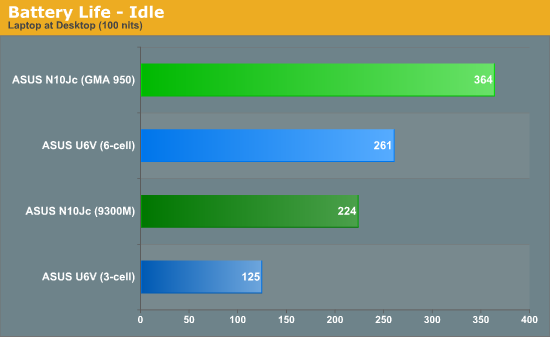
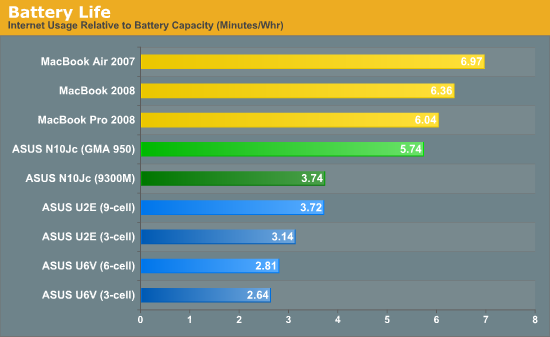
We don't have results for all of the test systems under each test scenario, but probably the most interesting performance metric is going to be battery life while surfing the web. There we see that the N10JC just manages to edge out the new Apple MacBooks, nearly matching the U2E with a 9-cell battery. That's great for Windows performance, but unfortunately you need to keep two things in mind. First, the Apple MacBook line is still offering better battery life relative to battery capacity. Second, the same MacBooks all offer quite a bit more performance -- in most cases they're at least twice as fast as the N10JC. That's the bad news; the good news? The ASUS N10JC still costs half as much as the cheapest MacBook, which definitely works in its favor.
One other item we have to address is the video decoding performance. x264 playback totally failed to stay in sync when we tried to watch a movie using just the CPU. We still ran the 720p battery tests, but if you want to watch such content you will need to enable the 9300M. We used Media Player Classic Home Theater (WMP-HC), following this guide, and didn't experience any problems. CPU usage dropped from 80%+ with noticeably delayed video to under 20% with no discernible synchronization problems.
We should also mention that system temperatures and noise levels on the N10JC are great. Temperatures never got above 32°C during testing, and the fan rarely kicked up to higher RPMs except during extended stress testing or gaming. We could not measure noise levels above the threshold of our SPL meter (30 dB).










45 Comments
View All Comments
Penti - Wednesday, December 24, 2008 - link
As I said before you wrote your post is that Vista Business includes downgrade rights (without volume license so small businesses can use it too even if they don't want to purchase SA via some license agreement).So there is a Asus N10 laptop for corporate use that has Vista business on it, the N10J-A2 I mentioned. A business version of the same netbook. So it has nothing to do with restriction but rather that this is a consumer variant / version of the somewhat business-oriented N10-series. It can have XP Pro preinstalled it's just that you need a VB license COA. And that it costs about 100 dollars more then XP Home for low end netbooks. It's cheaper then to get a retail (FPP) copy of XP Pro or Vista though. That would cost more then most netbooks. XP H can't be included in volume licenses.
JarredWalton - Wednesday, December 24, 2008 - link
ASUS is the one stating it's a "corporate" netbook, and outside of XP Home instead of Pro I think it succeeds well enough. It's not a corporate *laptop* by any means, but it can do what many traveling people would do. I went on a trip a week ago and used this laptop on the road; it was great to work in the airport for two hours (delayed flight) and then catch a two hour plane ride and still end up with nearly 50% battery remaining.MonkeyPaw - Wednesday, December 24, 2008 - link
I use my Eee 701 for "business" all the time, and I use Ubuntu + Open Office. Basically, I need it for viewing excel spreadsheets and hitting the internet in a pinch. It works well enough, and any critical documents stay on a thumb drive for easy moving about. I find there's no substitute for a full PC-interface when it comes to some things, and this Eee has served me well. In fact, I just read this entire article and posted this comment on my 701. Thanks, Anandtech, for a low-res-friendly website!skaaman - Sunday, December 28, 2008 - link
I think the point to be made here is that XP Home can't connect to a domain and therefore isn't an option in a corporate environment or small business environments. As was noted Vista business includes downgrade rights to XP Pro and therefore would fit the bill.Penti - Wednesday, December 24, 2008 - link
Well it's still a consumer netbook and not a "corporate netbook" if it hasn't VB (the only way to run XP Pro at home today apart from in the business). It's still the same hardware as their corporate version though, just that it has 1GB and 160GB instead of 2GB of ram and 320GB drive. You can't connect to a corporate network without at least XP Pro. Of course it lacks security features such as TPM/Bitlocker too. But truecrypt is always an alternative. Of course lacking built in 3G modem is also a downside on business stuff. I wouldn't buy one without, using it as a terminal would be what it's used for and useful for. You don't need more performance to run RDP / Citrix.